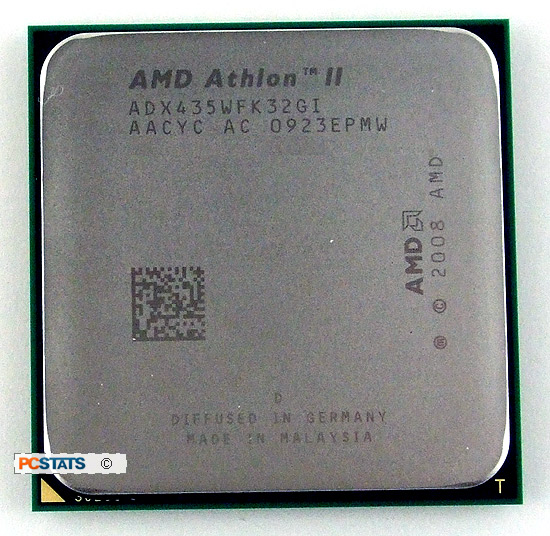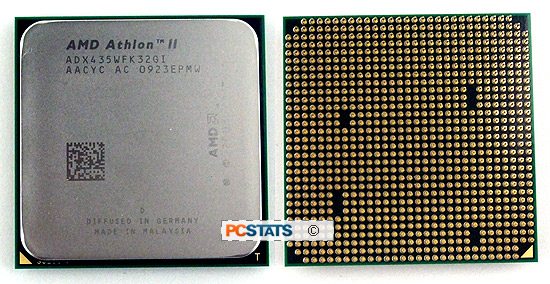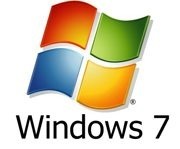
|
Enter the AMD Athlon II X3 435 processor, the focus of this PCSTATS review. It's a 2.9GHz triple-core socket AM3 CPU built on the Propus die. So is it better to get a dual core CPU, a triple-core CPU or a
quad-core CPU?
74% Rating: 
|
|
|
|
Home >
Reviews >
CPU / Processors >
AMD Athlon II X3 435 |
|
|
Ever
since processors with more than one computing core came into existance, a debate
has raged between those who favour the more multi-threading
friendly quad-core CPUs, and those that cite real-world performance gains
from higher clock speeds in what's predominantly been a single threaded
software universe. It's one of those "you say Tomato, I
say asymmetric multi-threaded application" arguments that computer sales
geeks absolutely love to spring on unsuspecting computer shoppers.
Let's face it, you are the giant human sized ball of string between their 11:15 coffee
break and lunch. But let's not get sidetracked by amusing balls of string. All that "multi-threaded" means, is that the computer is able to break up the workload and spread it across a number of computing cores. Analogously, four carpenters could frame a house faster than one would be able to.Is it better to get a dual core CPU, a triple-core CPU or a
quad-core CPU?
Since
you're reading PCSTATS to stay informed, the straightforward answer is a
quad-core CPU is the best choice right now, all things considered. However, for
those on a bit of a budget a triple-core CPU can be good value
too as you'll see momentarily. Multi-core processing is here to stay, and software able
to take advantage of many shiny processing cores is well on the road to
ubiquity. Intel of course has
its quad-core Core i5 CPU for mainstream computing demands and AMD has the
Athlon II in several variants, from two to four cores. The happy medium is more
cores running at a faster clock speed. To use the carpenter analogy,
three carpenters working fast can sometimes frame a house faster than four
carpenters working slowly. Benchmarks help when splitting hairs like this, but the point is that four is not always by default better than three. Processor clock speeds still have an impact on how quickly work spread between multiple processing cores is completed. Don't forget that!
Enter the AMD Athlon II X3 435 processor, the focus of this PCSTATS Processor review. It's a 2.9GHz triple-core
socket AM3 CPU built on AMD's "Propus" architecture. The Athlon II X3 435 is architecturally related to the AMD
Athlon II X4 620 processor, which means it's also manufactured with AMD's 45nm SOI production process. Thermal design power sits at a very reasonable 95W. Beyond
that, the Athlon II X3 435 is built without L3 cache so there is a performance hit in that respect. Fortunately the Athlon II
X3 435 still has 512KB of speedy L2 cache per core, for a total of 1.5MB.
 |
|
|
AMD Athlon II X3 435 Processor |
|
|
 |
| Tech
Specs |
|
Athlon II X3 435
(triple
core)
Clock: 2.9GHz
L1: 384KB total
L2:
1.5MB total
L3: none
Multiplier: 14.5x
Package:
938-pin
Socket: AM3 (AM2+)
organic mPGA
Core: 45nm
SOI
Transistor: ~300M
Power: 95W
Vcore:
0.85-1.425V
Cost: $87 USD |

| |
Like all
of AMD's recent processors, the Athlon II X3 435 has an on-board 128-bit wide
memory controller that can communicate with dual channel DDR2 or DDR3 system
memory at speeds of DDR2-1066 or DDR3-1333. Processor-to-system bandwidth tops out at
33.1GB/s and 37.3GB/s respectively. The processor uses HyperTransport 3.0 to communicate
with the system, using dual 16-bit links at a speed of 4.0GHz.
The Athlon II X3 435 is a triple core, and those extra
cores are ideal for tasks such as virtualization. Naturally the Athlon II X3 435
has full hardware virtualization support, allowing a single core to run a copy
of Windows XP inside of Microsoft Windows 7. Virtualized Windows XP will be
especially practical when it comes to legacy software applications that don't
run in Windows 7. The AMD Athlon II processor and AMD's 785G chipset are both
fully ready for Microsoft
Windows 7 incidently. PCSTATS has
included Windows 7 benchmarks in the review so you can see firsthand just
how ready.

As the Athlon II X4 435 is priced around $90 CDN ($87 USD, £60 GBP), it's moving into
a market crowded with AMD value-oriented processors. This includes AMD's
popular Athlon
II X2 250, the quad-core Athlon II X4
620 and the triple-core Phenom II X3 720. One has to wonder
if three cores at 2.9GHz and low power consumption figures will be enough to
distinguish the Athlon II X3 435 from the tidal wave of sub $100 CPUs flooding
the market right now.

Athlon II X3: Triple-Core
 AMD's Athlon II X3 435
processor is built with AMD's 'Propus' die, essentially a slimmed down version
of 'Deneb' which has been around since first 45nm Phenom II processor launched.
AMD's 'Propus' core consists of four individual computational cores with 512KB
of L2 cache each, but unlike 'Deneb' it has no L3 cache. The Athlon II X3 435
has one core disabled, so it actually has three functional cores instead of
four. This means the Athlon II X3 435's die is still 169mm2 in size, and still
consists of about 300 million transistors just like the Athlon II X4 620,
although the functional number of processing cores is less. AMD's Athlon II X3 435
processor is built with AMD's 'Propus' die, essentially a slimmed down version
of 'Deneb' which has been around since first 45nm Phenom II processor launched.
AMD's 'Propus' core consists of four individual computational cores with 512KB
of L2 cache each, but unlike 'Deneb' it has no L3 cache. The Athlon II X3 435
has one core disabled, so it actually has three functional cores instead of
four. This means the Athlon II X3 435's die is still 169mm2 in size, and still
consists of about 300 million transistors just like the Athlon II X4 620,
although the functional number of processing cores is less.
The absence
of L3 cache has a few consequences for the Athlon II X3 435 as you might expect. A large, fast
L3 cache is important for communication between processor cores and multi-threading efficiency after all.
When all three cores are busy processing threads, the L3 cache
acts as a pool that feeds the individual L2 caches. Ultimately this absence increases
the frequency that the processor has to fetch information from system
memory (your DDR2/DDR3 sticks) or virtual memory (your hard drive), both of
which are orders of magnitude slower than accessing on-die cache. This puts the
Athlon II X3 435 at a bit of a disadvantage when compared to the Phenom
II X3 720 Black Edition which is equipped with a 6MB L3 cache. Keep an eye
on the synthetic Sandra 2009 multicore efficiency and memory bandwidth results to see the
real-world impacts of this.
|
AMD Athlon
II / 64 Processors |
|
Processor Models |
Thermal Design
Power |
Clock
Speed |
Cache |
Price (CDN) |
|
AMD Athlon II X4 630 |
95W |
2.8 GHz |
2MB (4 x 512 L2) |
$122 |
|
AMD Athlon II X4 620 |
95W |
2.6 GHz |
2MB (4 x 512 L2) |
$110 |
|
AMD Athlon II X3
435 |
95W |
2.9 GHz |
1.5MB (3 x 512 L2) |
$89 |
|
AMD Athlon II X2 250 |
65W |
3.0 GHz |
2MB (2 x 1MB L2) |
$89 |
|
AMD Athlon 64 X2
7850 |
95W |
2.8 GHz |
3MB (1MB L2+ 2MB L3) |
$84 |
|
AMD Athlon X2 7750 |
95W |
2.7 GHz |
3MB (1MB L2 + 2MB L3) |
$72 |
|
AMD Athlon 64 X2 5200 |
65W |
2.7 GHz |
1MB (2 x 512 L2) |
$69 |
|
AMD Athlon 64 X2 5000 |
65W |
2.6 GHz |
1MB (2 x 512 L2) |
$64 |
The Athlon II X3 435 falls right in the middle of a
spectrum of entry level and mainstream AMD processors. Interestingly, it shares
the same price as AMD's popular Athlon II X2 250 processor, and while it has
less cache and a slightly slower clockspeed, the extra processor core can make a
big difference in multi-threaded benchmarks. Don't worry, both processors are
being strapped on to the PCSTATS test bench later on in this review.
While the Athlon II X3 435's power
consumption has likely diminished thanks to a disabled core, AMD has compensated by ramping
up the speed on the three fully-functional processing cores, so
the processor's TDP remains at 95W, the same as AMD's previous "Propus" processors.
First
though, let's see if disabling a processor core has had any effect on the Athlon
II X3 435's power consumption numbers...
|

